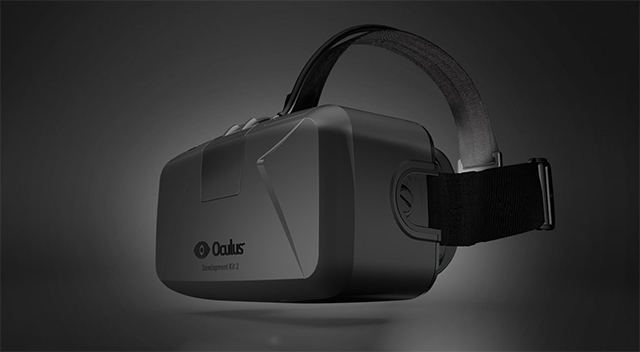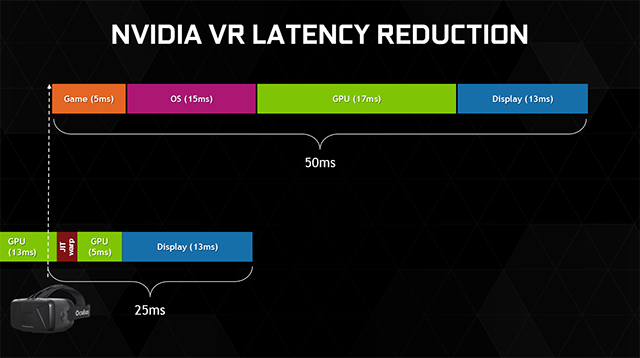Maxwell Virtual Reality Gaming
Note that this is an archived copy of the original article. Please see here for a more detailed explanation.
By Andrew Burnes on Thu, Sep 18 2014
Virtual Reality (VR) first found fame in the early 90s, following the release of The Lawnmower Man movie. Not only were the graphics terrible and the gameplay shallow, but motion tracking technology was in its infancy, resulting in laggy movement that, without fail, led to nausea.
Today, our improved understanding of the human brain allows us to better craft VR experiences that minimize nausea, while improvements in technology delivers photorealistic graphics for truly immersive gameplay. From super powerful GPUs to high-density displays, VR has developed to become an incredible all-consuming experience that even effusive descriptions cannot adequately portray.
For the last two years, since the reemergence of VR, NVIDIA has worked closely with companies such as Oculus to improve the VR experience. What we quickly discovered was that minimizing latency between an action occurring and the result being displayed was crucial for immersion and the avoidance of nausea. To that end, we have developed several new technologies that dramatically improve the VR experience, making Maxwell-based graphics cards the best for fluid, fun virtual reality experiences.
The standard VR pipeline from input in (when you move your head) to photons out (when you see the action occur in-game) is about 57 milliseconds (ms). However, for a good VR experience, this latency should be under 20ms. Presently, a large portion of this is the time it takes the GPU to render the scene and the time it takes to display it on the headset (about 26ms). To reduce this latency we've reduced the number of frames rendered in advance from four to one, removing up to 33ms of latency, and are nearing completion of Asynchronous Warp, a technology that significantly improves head tracking latency, ensuring the delay between your head moving and the result being rendered is unnoticeable.
Combined, and with the addition of further NVIDIA-developer tweaks, the VR pipeline is now only 25ms. With further work and updated technology we expect consumer versions of VR to be even more responsive.
The other requirement for VR is high framerates. At present, 75 frames per second, per eye, at 960x1080 is desired for fluid gameplay. Achieving this level of performance is akin to rendering at 4K, making the GeForce GTX 980 the recommended card for VR.
However, to ensure the ultimate experience with rock solid framerates, which is crucial for avoiding eye strain and jarring frame drops, a fast SLI configuration is recommended. In traditional games SLI doubles performance, letting you play at higher resolutions and with more eye candy. In VR games, SLI rendering introduces a frame of latency, which is the antithesis of our work mentioned earlier. To avoid this frame of latency we have developed "VR SLI", which has each GPU output to a separate eye in the VR headset. This allows games to fully utilize both GPUs in parallel, and increase delivered frame rates.
Before VR there were a number of 3D technologies, such as our own 3D Vision. Fundamentally, the rendering technologies of 3D Vision and VR are extremely similar: 2 slightly different images displayed in such a way to create a 3D dimensional effect. Realizing this, we have developed Auto Stereo, which will convert 3D Vision-compatible games into VR experiences, with mouse and keyboard commands mapped to VR inputs like head movement, similar to Gamepad Mapper on NVIDIA SHIELD devices, which maps touch and motion inputs to physical controls. Auto Stereo will be delivered automatically through GeForce Experience.
Finally, we will leverage Voxel Global Illumination (VXGI), Dynamic Super Resolution (DSR), and Multi-Frame Sampled Anti-Aliasing (MFAA) to increase image quality and performance in compatible games. VXGI-enabled games will be significantly more immersive and realistic in VR, DSR will enable higher fidelity of games on VR displays, further improving immersion and realism, and MFAA will improve anti-aliasing whilst simultaneously improving performance, which as discussed is crucial for VR.
Together, these many VR features make Maxwell GPUs such as the GeForce GTX 980 the best option for VR enthusiasts who want the definitive VR experience, free from latency and nausea-inducing artifacts, and with unprecedented image quality.
With a Maxwell GPU, NVIDIA delivers a VR solution second to none.
 Previous
Previous


Comments
This comment section is currently disabled. Click here to enable comments and load all Disqus related resources
Please note that by enabling and loading these Disqus resources, you are agreeing to allow everything that comes with a Disqus comment section, including their cookies and all scripting.
This comment section is currently enabled. Click here to disable comments and unload all Disqus related resources
Please note that I have absolutely zero control over this comment section. It is still administered entirely by Nvidia themselves. I have no moderation power whatsoever and don't necessarily endorse any of the comments posted here. In fact, I don't believe this comment section adds much value to the article to begin with but included it only because it existed on the original.